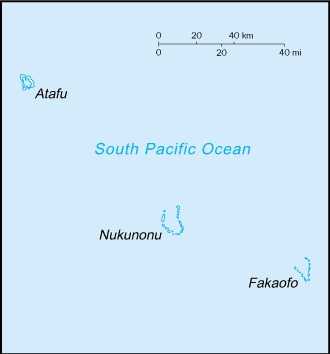Introduction
Background
Originally settled by Polynesians from surrounding island groups, the Tokelau Islands were made a British protectorate in 1889. They were transferred to New Zealand administration in 1925.
Geography
Area
total: 12 sq km
land: 12 sq km
water: 0 sq km
Climate
tropical; moderated by trade winds (April to November)
Natural resources
Fisheries
People and Society
Population
total: 1,647 (2019 est.)
Ethnic groups
Tokelauan 64.5%, part Tokelauan/Samoan 9.7%, part Tokelauan/Tuvaluan 2.8%, Tuvaluan 7.5%, Samoan 5.8%, other Pacific Islander 3.4%, other 5.6%, unspecified 0.8% (2016 est.)
Languages
Tokelauan 88.1% (a Polynesian language), English 48.6%, Samoan 26.7%, Tuvaluan 11.2%, Kiribati 1.5%, other 2.8%, none 2.8%, unspecified 0.8% (2016 ests.)
Religions
Congregational Christian Church 50.4%, Roman Catholic 38.7%, Presbyterian 5.9%, other Christian 4.2%, unspecified 0.8% (2016 est.)
Population growth rate
-0.01% (2019 est.)
Government
Government type
parliamentary democracy under a constitutional monarchy
Executive branch
chief of state: King CHARLES III (since 8 September 2022); represented by Governor-General of New Zealand Dame Cindy KIRO (since 21 September 2021); New Zealand is represented by Administrator Don HIGGINS (since June 2022)
head of government: (Ulu o Tokelau) Alapati TAVITE (since 12 March 2024); note - position rotates annually among the three Faipule (village leaders) of the atolls
Legislative branch
description: unicameral General Fono (20 seats apportioned by island - Atafu 7, Fakaofo 7, Nukunonu 6; members directly elected by simple majority vote to serve 3-year terms); note - the Tokelau Amendment Act of 1996 confers limited legislative power to the General Fono
Economy
Economic overview
small New Zealand territorial island economy; labor force can work in New Zealand or Australia; significant remittances; largely solar-powered infrastructure; reliant on New Zealand funding; stamp, coin, and crafts producer
Real GDP (purchasing power parity)
$7,711,583 (2017 est.)
Real GDP per capita
$6,004 (2017 est.)
$4,855 (2016 est.)
$4,292 (2015 est.)
Agricultural products
coconuts, root vegetables, tropical fruits, pork, bananas, eggs, chicken, pork offal, pork fat, fruits (2022)
Industries
small-scale enterprises for copra production, woodworking, plaited craft goods; stamps, coins; fishing
Exports
$103,000 (2015 est.)
Exports - partners
Poland 97%, Singapore 0%, Brazil 0%, South Africa 0%, Rwanda 0% (2022)
Exports - commodities
cars, iron fasteners, garments, silver, perfumes (2022)
Imports
$15,792,720 (2015 est.)
Imports - partners
Germany 40%, Sweden 10%, Singapore 8%, France 5%, Netherlands 5% (2022)
Imports - commodities
cars, orthopedic appliances, surveying equipment, butter, nuts (2022)
Exchange rates
New Zealand dollars (NZD) per US dollar -
Exchange rates:
1.543 (2017 est.)
Page last updated: Wednesday, May 22, 2024


